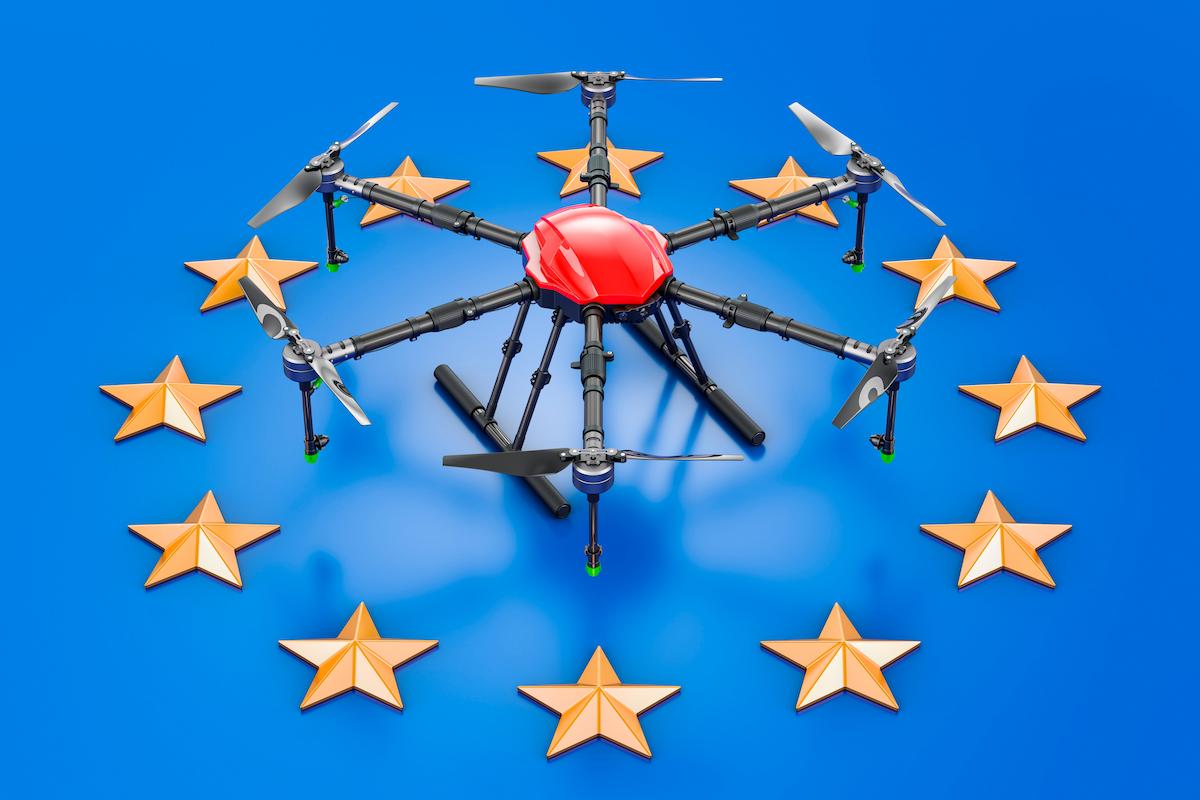By: Joanna Wieczorek* and Yves Morier**
Imagine a future where drones zip through the skies, delivering packages, inspecting infrastructure, and capturing breathtaking views without ever colliding with manned aircraft. This is the promise of U-space, a European initiative designed to manage drone traffic efficiently and safely. U-space is the European counterpart to the global UTM (Unmanned Traffic Management) concept. It aims to integrate drones into existing airspace systems seamlessly. In this article, we provide an overview of U-space, provide practical advice to states desiring to implement it and focus on some of the most recent updates across Europe.
What is U-space?
U-space is more than just a set of rules; it’s a comprehensive enabling concept that leverages high levels of digitalization and automation to ensure routine safe, efficient, environmentally friendly and secure drone operations that also respect people´s privacy. It provides a structured environment for scaling drone operations in a manner that ensures that drones and manned types of aviation can coexist without compromising safety.
The U-space concept has been developed to facilitate UAS traffic management through a clear and effective interface to manned aviation, air traffic management (ATM) / air navigation services (ANS) providers and authorities. It is the European interpretation of the concept of UTM developed by ICAO. Its aim is to create a space for UAV operations, the specificity of which is very different from manned operations, without jeopardizing safety of either sector.
The U-space concept involves creating a network of services that support drone operations, from simple tasks like registration and identification to complex functions like conflict detection and avoidance.
Regulatory Framework
Initial work on U-space was launched in 2017, when in June, the SESAR Joint Undertaking (SESAR JU) published a blueprint that envisaged a phased development.
Regulatory work was launched late 2018 and culminated in an EASA Opinion issued in March 2020.
The European Commission has since developed a general regulatory framework entirely devoted to the concept of U-space, based on the EASA’s opinion: Regulation 2021/664. Regulation 2021/664 and its two other associated regulations ( 2021/665 (Dynamic reconfiguration of Airspace) and 2021/666 (i-conspicuity)) complement regulations 2019/ 945 (technical approval of UAS) and 2019/ 947 (UAS operations).
This framework outlines requirements for airspace management, service providers and drone operators to ensure that all stakeholders are certified and compliant. The regulation also mandates specific services like network information, geo-awareness and flight information services, with optional services including weather information and conformance checks. Below we provide some of its origins and highlights.
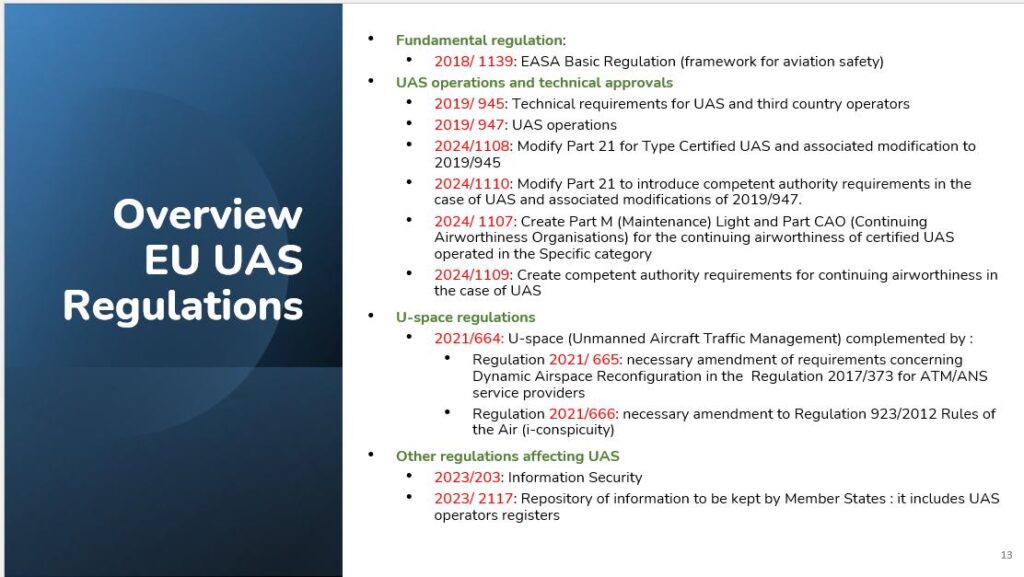
Key Principles
The regulatory framework for U-space is built on several key principles derived from ICAO guidance:
- Oversight Responsibility: The provision of UTM services will be overseen by the operator to ensure accountability and compliance with safety standards.
- Prioritization Policies: Existing policies for aircraft prioritization, such as emergency responses and public safety operations, remain applicable, with UTM practices aligned to support these policies.
- Equitable Access: Access to airspace remains equitable, provided each aircraft complies with relevant regulations and performance requirements.
- Operator Qualification: UAS operators and remote pilots must be qualified to perform normal and contingency procedures based on the airspace and UTM services used.
- State Oversight: States have unrestricted access to UAS operators, remote pilots, and drone data to ensure safety and security oversight.
- Safety Culture: The development of a safety culture within the UTM community is crucial for effective operations.
- Incident Reporting: Free and open reporting of accidents and incidents will be facilitated for all stakeholders
Taking these ICAO principles, the SESAR JU blueprint defined its own key principles for U-space and developed a phased approach, illustrated below. Key words include notably the following ones: safe, secure, risk and performance-based approach, respecting the environment and privacy of people and ensuring a fair and equitable access to airspace, scalable, flexible, competitive and cost-effective.
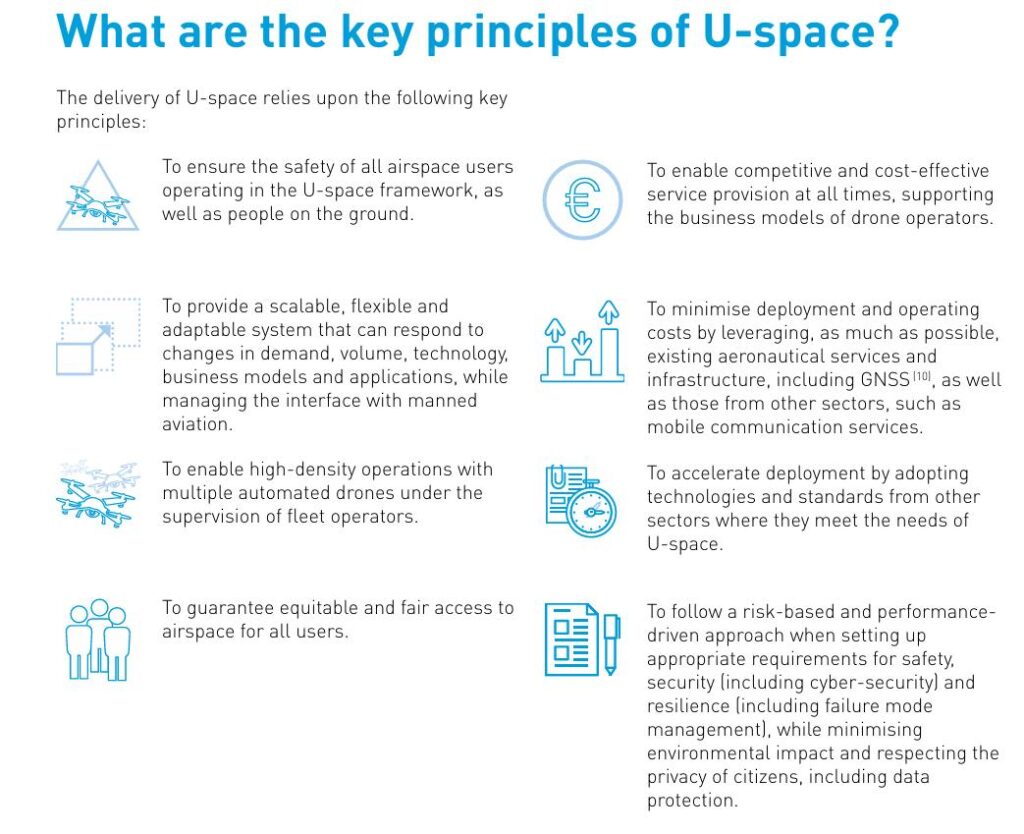
The same document lists factors that must be considered by each state that wishes to implement U-space.
Tiers of Services
The U-space full services will be characterized by highly automated and highly connected drones. U-space services are categorized into four tiers:

- U1 – Foundation Services: These include electronic registration, identification, and geofencing, laying the groundwork for drone operations.
- U2 – Initial Services: This level involves flight planning, approval, tracking, and integration with conventional air traffic control systems.
- U3 – Advanced Services: Here, drones benefit from features like conflict detection and automated detect-and-avoid systems, ideal for dense urban environments.
- U4 – Full Services: The highest level offers advanced automation and connectivity, enabling highly complex drone operations.
All of these principles, in reality, require states to consider a number of issues in implementation.
Practical Guidance for States Implementing U-space
Because U-space must be designed for highly automated UAVs (including autonomous ones), open and democratic, performance-based, agile and flexible enough to evolve together with the technology and globally interoperable, the process of introducing U-space must take into account not only the current state of UAV market and technology, but also its expected further – and quick – development. The first step is to appreciate several factors about one’s own environment.
Initial Factors To Consider
States that desire to implement U-space should consider a number of factors, such as: the types of UAV and their performance characteristics, adequacy and complexity of the existing airspace structure, spectrum availability and sustainability, nature of operations, type and density of existing and anticipated traffic (both manned and unmanned), operational capacity of the UTM system including airspace constraints, levels of and extent of automation capabilities in the UTM system and in the UAV, regulatory structure, meteorological considerations, the requirement for all UAV in the UTM airspace volume to be cooperative, detection/separation of non-cooperative UAV, management of aeronautical information service (AIS)/aeronautical data, and geographic information systems (GIS) data or additional geospatial data applicable to the UTM airspace.
Establishing U-space Airspace
Creating a U-space airspace involves more than just designating a new airspace class. Initially conceived as a separate airspace class alongside A, B, C, D, or E, the U-space concept continues to evolve towards an airspace structure tailored for low-level UAV operations, particularly in urban areas. This evolution is driven by the realization that drone operations are generally limited to lower altitudes and specific geographic areas. Below we highlight some practical considerations for states seeking to implement U-space.
Risk Assessments and Coordination
Before establishing a U-space airspace, states must conduct four critical risk assessments: Safety, Security, Environment, and Privacy. These assessments are complemented by coordination with local authorities, ensuring that all stakeholders are aligned before, during, and after the creation of the U-space airspace.
Mandatory and Optional Services
U-space requires 4 mandatory services, including network information, geo-awareness, flight authorisation and flight information services. Optional services include weather information and conformance checks. These services are designed to mirror existing ATM systems but with unique features tailored for unmanned aircraft. After establishing U-space foundational services, further steps will require providing initial, advanced, and eventually full U-space services.
Certification of Service Providers
Providers of U-space services, including those offering the Common Information Service (this when a network information service is centralized), must be certified by the Competent Authority. Regulation 2021/664 defines common information service as, “a service consisting in the dissemination of static and dynamic data to enable the provision of U-space services for the management of traffic of unmanned aircraft.”
The Common Information Service plays a crucial role in disseminating static and dynamic data necessary for managing unmanned aircraft traffic.
Separation from Manned Aircraft
To ensure safety, U-space employs several strategies to separate drones from manned aircraft. In controlled airspace, as Regulation 2021/665 outlines, dynamic airspace reconfiguration is used to adjust U-space volumes. In non-controlled airspace, as noted in Regulation 2021/666, electronic visibility (i-conspicuity) is required for manned aircraft entering U-space areas.
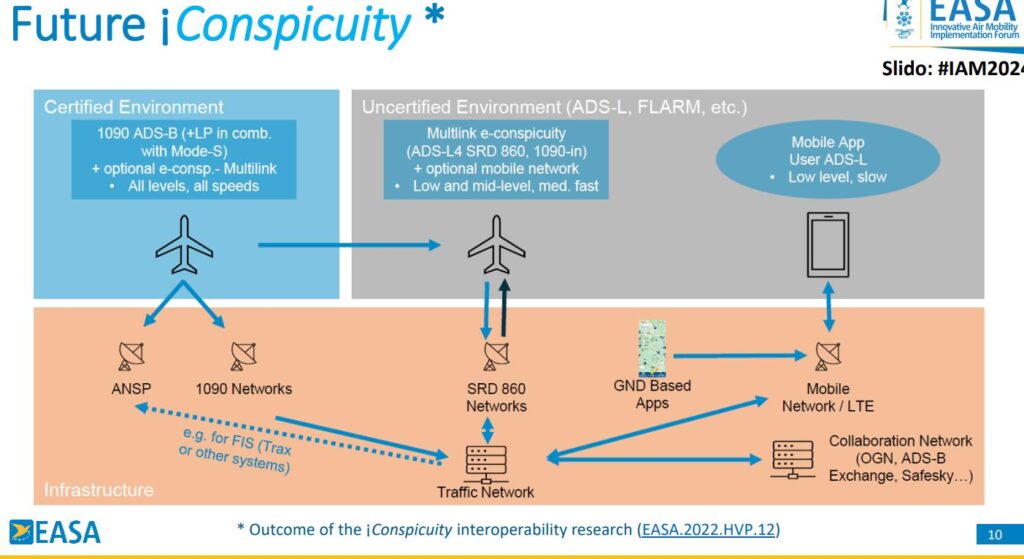
U-space Updates
Despite having a well-developed framework, U-space remains a future concept and has not been widely implemented. However, some states have made great progress and significant testing has been conducted to validate the readiness of U-space for deployment. EASA, at its Innovative Air Mobility Forum last October, provided a snapshot of U-space implementation

The Global UTM Association (GUTMA) broadly confirmed this assessment in its Ecosystems Readiness Index Report.
GUTMA’s Assessment
The recently published GUTMA Ecosystems’ Readiness Index 2024 highlighted Europe’s leadership in legislation as having set a benchmark to enable commercial and scalable beyond visual line of sight (BVLOS) drone operations.
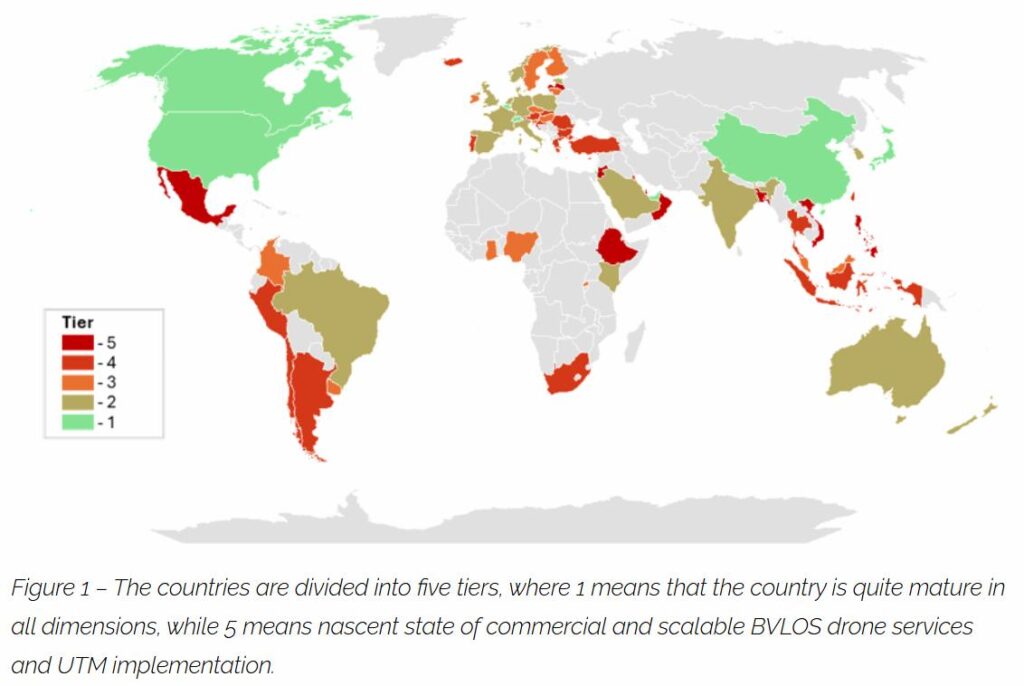
A review of the GUTMA report for Europe indicates that two countries – Belgium and Switzerland – are in Tier 1, eleven in Tier 2, five in Tier 3 and the remaining ones in Tiers 4 and 5. Tier 1 indicates countries that are quite mature in all dimensions and Tier 5 indicates a nascent state of UTM implementation. This shows a mixed picture concerning implementation of U-space in Europe.
The European majority of countries in Tier 1 and 2 have a good ranking in the dimensions of Regulations, Governance, Strategy, Operations and Technology. Their ranking in the dimension of Market is rather low.
Europe is the leader in terms of regulation having adopted a comprehensive set of regulations addressing U-space in 2021. It is therefore not a surprise that European countries have good rankings for the dimension of regulations.
Another strong point in Europe is governance in particular due to the network of U-space stakeholders put in place by the Commission, EASA, EUROCONTROL and SESAR. This network aims to promote dialogue and the exchange of experience amongst the early implementers of U-space and their associated communities – U-space service providers, UAS operators, other concerned public and private undertakings, U-space regulators and smart cities, etc. This network meets several times a year and has established a list of test centers in Europe
It is interesting to note that three ports in Europe have put in place U-space systems that are not yet certified in accordance with regulation 2021/664 but that allow for a very valuable experience: Antwerp, Hamburg and Rotterdam. Ports are favorable grounds for BVLOS drone activities due to their size and their very nature. For example, drones can be used to transport samples, small parts from ships to shore or within the port, perform pollution control and general surveillance of the port. Creating a U-space airspace makes sense in such cases.
Below provide highlights from Belgium and Switzerland:
Belgium
Belgium is implementing the European regulatory framework for UAS operations and UTM, including drone geozones. Like Denmark, Belgium also has strategic frameworks for airspace management, such as “Belgium’s Airspace Vision 2030.”
The country fosters cooperation between the private and public sectors through entities like the Belgian Drone Association and Flanders Make and The Advisory Board of the Belgian Civil Aviation Authority involves stakeholders in shaping drone-related policies.
An advanced UTM system has been implemented through a collaboration involving ANSP Skeyes and Unifly. The system, known as Droneguide, facilitates digital drone planning and approval, integrating with the Drone and Aerial Activities Platform.
Switzerland
Switzerland has implemented the EU Regulations and has developed a fee structure related to U-space services. It has created a public-private partnership called Swiss U-space Implementation (SUSI) to facilitate the safe and secure operations of drones in Swiss airspace. A national UAS operations and UTM strategy has also been established.
A basic UTM system is in place that incorporates geo-zones and provides permissions for drone activities. The first U-space airspace will be created in Zurich. The ANSP manages the Flight Information Management System which integrates air traffic management with U-space Service Providers (USSP).
The report lacks detailed information concerning drone operations and the size of UTM market activities. However the Drone Industry Association of Switzerland (DIAS) is in charge of publishing the annual “Swiss Drone Industry” report where the most important calculations will be provided.
While only a handful of countries have U-space underway, research and development (R&D) otherwise continues to prove U-space concepts in action.
R&D Proofs of Concept
One of the most notable demonstrations took place in September 2017 in Geneva, Switzerland. This live U-space demo showcased several key features, including:
- Electronic Registration and Identification: Drones were electronically registered and identified, ensuring traceability and compliance.
- Integration with ATC: The demo integrated with skyguide’s air traffic control radar system, demonstrating seamless interaction between manned and unmanned aviation.
- Flight Planning and Situational Awareness: Dynamic situational awareness and flight planning were showcased, highlighting the system’s ability to manage drone operations in real-time.
- Geo-Information and Geofencing: Access to geo-information and geofencing capabilities was demonstrated, ensuring drones operated within designated areas.
- Digital Airspace Approval and Management: The demo included digital airspace approval and flight management, streamlining the process for drone operations.
- Real-Time Telemetry Data: Real-time drone telemetry data was transmitted, providing critical insights into drone performance and location.
This demonstration note only proved that U-space is ready for deployment in Europe; it arguably paved the way for widespread adoption and integration into existing airspace systems. With even more research and testing, U-space will move Europe closer to widespread adoption.
SESAR JU is also conducting extensive research to further develop the concept of U-space and assist in the harmonious development of rules. Eleven projects are active and 30 are closed. Further information may be found here.
Future Prospects
Europe has been a leader in developing regulatory frameworks for UAS operations. U-space has served as a model for other regions. The EU’s early adoption of regulations has facilitated commercial drone activities by providing clear guidance for member states and industries to adopt a unified approach.
However, challenges persist in translating these frameworks into operational deployments. Despite significant investments in R&D, frustration continues over the slow pace of commercial U-space operations across member states. This underscores the need for continued innovation and collaboration to bridge the gap between regulatory readiness and operational reality.
In the meantime, regulatory work on U-space continues to be supported by key organizations such as EUROCONTROL and EUROCAE. EUROCONTROL contributes through methodologies like Air Space Risk Assessment and by supporting the European Network of U-space Stakeholders. Additionally, EUROCAE plays a role through its Working Group 105, Subgroup 3, focused on UTM standards. EASA is also actively involved in refining the regulatory environment, planning major revisions to the AMC/GM to ensure safe and efficient U-space implementation. These collaborative efforts underscore the commitment to making U-space a reality, paving the way for drones to become integral to European aviation.
As technology also continues to advance and regulatory frameworks mature, U-space will undoubtedly unlock new opportunities for drone operations across Europe. This will not only enhance safety and efficiency but also foster economic growth by creating a unified European market for drone services.
In short, U-space represents a significant step forward in drone management. It offers a structured and safe environment for UAVs to operate. As Europe continues to refine and implement its U-space services, the potential for drones to contribute to various industries in Europe becomes increasingly promising.
* Joanna Wieczorek is our Europe Ambassador. See her profile here.
**Yves Morier graduated from the French Civil Aviation Academy as an Air Transport Engineer (MSC) in 1975. After his military service, he joined the French CAA (DGAC) in 1979. He was seconded as Regulation Director to the Joint Aviation Authorities (JAA) in 1993. In 2004, he joined EASA where he occupied several management posts. His last assignment was as Principal Advisor New technologies to the Director of Flight Standards where he contributed to the development of the first EU regulations on drones. He retired in 2019 and since then has remained involved in Drones and Advanced Air Mobility, mainly as a volunteer.

